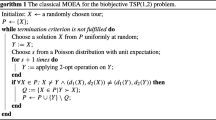Abstract
A novel bio-inspired optimization algorithm called elephant search algorithm (ESA) has been applied to solve NP-hard problems including the classical traveling salesman problem (TS) in this paper. ESA emerges from the hybridization of evolutionary mechanism and dual balancing of exploitation and exploration. The design of ESA is inspired by the behavioral characteristics of elephant herds; hence, the name Elephant Search Algorithm which divides the search agents into two groups representing the dual search patterns. The male elephants are search agents that outreach to different dimensions of search space afar; the female elephants form groups of search agents doing local search at certain close proximities. By computer simulation, ESA is shown to outperform other metaheuristic algorithms over the popular benchmarking optimization functions which are NP-hard in nature. In terms of fitness values in optimization, ESA is ranked after Firefly algorithm showing superior performance over the other ones. The performance of ESA is most stable when compared to all other metaheuristic algorithms. When ESA is applied to the traveling salesman problem, different ratios of gender groups yield different results. Overall, ESA is shown to be capable of providing approximate solutions in TSP.





























Similar content being viewed by others
References
Reynolds CW (1987) Flocks, herds and schools: a distributed behavioral model. Comput Graph 21(4):25–34
Jarraya B, Bouri A (2012) Metaheuristic optimization backgrounds: a literature review. Int J Contemp Bus Stud 3(12):31–44
Hoang DT (2008) Metaheuristics for NP-hard combinatorial optimization problems. PhD Thesis, Electrical and Computer Engineering, National University of Singapore
Yang XS (2010) Engineering optimization: an introduction with metaheuristic applications. Wiley, Hoboken, NJ p 347
Yang XS (2010) A new metaheuristic bat-inspired algorithm. In: Nature inspired cooperative strategies for optimization (NICSO), Series Studies in Computational Intelligence, vol 284, pp 65–74
Yang XS (2009) Firefly algorithms for multimodal optimization. Stochastic algorithms: foundations and applications, SAGA 2009. Lecture Notes in Computer Sciences 5792:169–178
Kennedy J, Eberhart R (1995) Particle swarm optimization. In: Proceedings of IEEE international conference on neural networks IV, pp 1942–1948
Fong S, Deb S, Yang X-S (2015) A heuristic optimization methodinspired by wolf preying behavior. Neural Comput Applic 26:1725–1738
Phelps S, McBurney P, Parsons S (2010) Evolutionary mechanism design: a review. Auton Agent Multi-Agent Syst 21:237–264
Yang XS, Deb S, Fong S (2014) Metaheuristic algorithms: optimal balance of intensification and diversification. Appl Math Inf Sci 8(3):977–983
Elephants Behaviours. http://seaworld.org/animal-info/animal-infobooks/elephants/behavior/
Vidya TNC, Sukumar R (2005) Social and reproductive behaviour in elephants. Curr Sci 89(7):1200–1207
Benchmarking Optimization Functions. http://www.sfu.ca/~ssurjano/optimization.html
Fong S, Wong R, Pichappan P (2015) Debunking the designs of contemporary nature-inspired computing algorithms: from moving particles to roaming elephants. In: The fourth international conference on future generation communication technology (FGCT), IEEE Press, 29–31 July, pp 1–11
TSPLIB, http://www.iwr.uni-heidelberg.de/groups/comopt/software/TSPLIB95/
Optimal solutions for symmetric TSPs. http://comopt.ifi.uni-heidelberg.de/software/TSPLIB95/STSP.html
Deb S, Fong S, Tian ZH (2015) Elephant search algorithm for optimization problems. In: 2015 tenth international conference on digital information management (ICDIM) (Oct.) IEEE, Jeju
Acknowledgments
The authors are thankful for the financial support from the Research Grant Temporal Data Stream Mining Using Incrementally Optimized Very Fast Decision Forest (iOVFDF), Grant No. MYRG2015-00128-FST, offered by the University of Macau, FST, and RDAO.
Author information
Authors and Affiliations
Corresponding author
Rights and permissions
About this article
Cite this article
Deb, S., Fong, S., Tian, Z. et al. Finding approximate solutions of NP-hard optimization and TSP problems using elephant search algorithm. J Supercomput 72, 3960–3992 (2016). https://doi.org/10.1007/s11227-016-1739-2
Published:
Issue Date:
DOI: https://doi.org/10.1007/s11227-016-1739-2




